The Face on Film
Autor Noa Steimatskyen Limba Engleză Paperback – 9 mar 2017
Preț: 366.92 lei
Preț vechi: 469.53 lei
-22% Nou
Puncte Express: 550
Preț estimativ în valută:
70.21€ • 75.08$ • 58.54£
70.21€ • 75.08$ • 58.54£
Carte tipărită la comandă
Livrare economică 07-12 aprilie
Preluare comenzi: 021 569.72.76
Specificații
ISBN-13: 9780199863167
ISBN-10: 0199863164
Pagini: 296
Ilustrații: 193 screenshots
Dimensiuni: 251 x 178 x 15 mm
Greutate: 0.61 kg
Editura: Oxford University Press
Colecția OUP USA
Locul publicării:New York, United States
ISBN-10: 0199863164
Pagini: 296
Ilustrații: 193 screenshots
Dimensiuni: 251 x 178 x 15 mm
Greutate: 0.61 kg
Editura: Oxford University Press
Colecția OUP USA
Locul publicării:New York, United States
Recenzii
The Face on Film is a stunning success, and easily among the very best cinema books of the past decade.
Noa Steimatsky's intriguing book The Face on Film oscillates between straightforward history of various cinematic tropes of the face and theoretical treatise on modernity and then postmodernity's grasp of the human face. Her study charts the transformation of mythic faces of cinema's past into a complex commercial image and existential unintelligibility within postmodernity. Refreshingly, the book offers a history of performance disguised as high theory and will pique the interest of film and cultural theorists and performers and artists alike.
Noa Steimatsky's intricate prose flows like blood through the capillaries of The Face on Film making its subject throb, blush, and sometimes turn pallid. Her study will be one of a handful to last as long as the filmmakers she so precisely, lovingly, longingly treats: Dreyer, Hitchcock, Antonioni, Warhol, Bresson. Without blinking, and without hesitating, Steimatsky confronts and describes-draws and draws out-the experience of the face as well as of film.
The Face on Film is a brilliant meditation on the historical importance of the face both inside and outside the cinema and the way questions of its signification and efficacy have been exacerbated in modernity and late modernity. Detailed and elegant readings of films buttress Steimatsky's compelling argument that the opacity or illegibility of the face always accompanies and subtends its legibility. She directly addresses the question of our enduring cultural obsession with this enigmatic yet central site linked to identity, expressivity, singularity and contingency. Vigorous, intelligent and lucid, this work will surely have a strong impact on current debates about aesthetics and ethics.
With this powerful book, Noa Steimatsky emerges as one of our profoundest observers of the possibilities of the medium of film. The Face on Film both caresses the surface and probes the profundities of the human face in cinema. Balancing a historical overview, examination of the long critical engagement with cinematic faces, and close analysis of carefully selected films, Steimatsky demonstrates the capacity of the face on film to both reveal and conceal meaning and emotion.
Despite its grand title, The Face on Film is no bubbly celebration of the beautiful countenances that comprise the history of big-screen glitz and glamor. Rather, UC Berkeley professor Noa Steimatsky investigates the ontological repercussions of capturing the human face via motion picture photography, and does so by surveying canonical film theory and criticism ... In order to reap the rewards of Steimatskys analyses, then, readers must exercise patience ... And they will be rewarded ... her observations [are] insightful, well-argued, and poetically expressed. Especially wonderful is the chapter on the multitudes contained in Warhols deceptively, eerily minimalist portraits of Edie Sedgwick.
Noa Steimatsky's intriguing book The Face on Film oscillates between straightforward history of various cinematic tropes of the face and theoretical treatise on modernity and then postmodernity's grasp of the human face. Her study charts the transformation of mythic faces of cinema's past into a complex commercial image and existential unintelligibility within postmodernity. Refreshingly, the book offers a history of performance disguised as high theory and will pique the interest of film and cultural theorists and performers and artists alike.
Noa Steimatsky's intricate prose flows like blood through the capillaries of The Face on Film making its subject throb, blush, and sometimes turn pallid. Her study will be one of a handful to last as long as the filmmakers she so precisely, lovingly, longingly treats: Dreyer, Hitchcock, Antonioni, Warhol, Bresson. Without blinking, and without hesitating, Steimatsky confronts and describes-draws and draws out-the experience of the face as well as of film.
The Face on Film is a brilliant meditation on the historical importance of the face both inside and outside the cinema and the way questions of its signification and efficacy have been exacerbated in modernity and late modernity. Detailed and elegant readings of films buttress Steimatsky's compelling argument that the opacity or illegibility of the face always accompanies and subtends its legibility. She directly addresses the question of our enduring cultural obsession with this enigmatic yet central site linked to identity, expressivity, singularity and contingency. Vigorous, intelligent and lucid, this work will surely have a strong impact on current debates about aesthetics and ethics.
With this powerful book, Noa Steimatsky emerges as one of our profoundest observers of the possibilities of the medium of film. The Face on Film both caresses the surface and probes the profundities of the human face in cinema. Balancing a historical overview, examination of the long critical engagement with cinematic faces, and close analysis of carefully selected films, Steimatsky demonstrates the capacity of the face on film to both reveal and conceal meaning and emotion.
Despite its grand title, The Face on Film is no bubbly celebration of the beautiful countenances that comprise the history of big-screen glitz and glamor. Rather, UC Berkeley professor Noa Steimatsky investigates the ontological repercussions of capturing the human face via motion picture photography, and does so by surveying canonical film theory and criticism ... In order to reap the rewards of Steimatskys analyses, then, readers must exercise patience ... And they will be rewarded ... her observations [are] insightful, well-argued, and poetically expressed. Especially wonderful is the chapter on the multitudes contained in Warhols deceptively, eerily minimalist portraits of Edie Sedgwick.
Notă biografică
Noa Steimatsky is Visiting Associate Professor of Italian Studies at the University of California--Berkeley.








